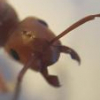I collected five queen ants in the backyard of a friend's suburban house in Maryland on 8/22/2018 in the early evening (between 7-9pm). The queens were collected from on top of patches of rock in a mostly grassy area. I'm fairly positive whatever species these ants are were having a nuptial flight in my area today since I saw many small (presumably) male alates flying around and then I was able to find quite a few female alates (with and without wings) scurrying about. The queen is 3/8 of an inch long so between 9-10mm. The ant has a black head and thorax but the abdomen is somewhat brown and hairy.
Can anyone help me ID these ants? (and confirm that they are queens)
Picture of the ants here: https://imgur.com/gallery/dgwwJxY
















